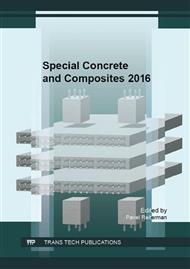p.3
p.12
p.18
p.27
p.33
p.38
p.44
p.52
Long-Term Mechanical Properties of Fiber Reinforced Polymer Bars Exposed to Alkali Environment: Experimental Investigation
Abstract:
This paper deals with actual issues concerning the design and the utilization of modern composite reinforcement (FRP) in concrete structures. These advanced composite materials are, especially if the whole life cycle of the structure is considered, gradually becoming a convenient alternative to ordinary steel reinforcement. The structure reinforced with FRP reinforcement (as well as the structure reinforced with steel reinforcement) has to be designed with regard to sufficient endurance, serviceability and durability. The long-term material properties of FRP reinforcement embedded in concrete, which are influenced by temperature, load magnitude and ambient environment, must be considered during design of the structure. A high alkali environment of concrete with pH higher than 12.0 acts mainly on glass fibres which degrade and their mechanical properties are reduced consequently. The used matrix creates a barrier which insulates the bearing fibres against alkali ions attack. The main objective of the paper is therefore to describe behaviour of composite as a whole. The experimental approach and results which were reached during the tests are also presented. An effort was to specify the impact of alkali environment on the long-time properties of developed reinforcement which could be used in durable concrete structures.
Info:
Periodical:
Pages:
27-32
Citation:
Online since:
December 2016
Keywords:
Price:
Сopyright:
© 2017 Trans Tech Publications Ltd. All Rights Reserved
Share:
Citation:


